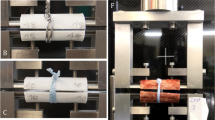Abstract
This work proposes a new testing methodology and an original testing bench to evaluate and compare the abrasive properties of orthopedic cables used in the surgical treatment of orthopedic disorders. This bench generates the cut-out reciprocal movement of a bone surrogate or biological bone specimen against a cable and it serves to evaluate the bone abrasion kinetics and the loss in cable tension when it cuts through bone. To validate the proposed methodology, a cut-out reciprocal testing study was performed using a conventional titanium orthopedic cable on both polyurethane foam bone surrogates and porcine vertebrae specimens. It was observed that the cutting rate and consequently the loss in cable tension were much lower for the porcine specimen than that observed for the bone surrogate given higher hardness of cortical bone compared to polyurethane. The methodology developed allows therefore comparative studies on the abrasiveness and on the ability to maintain the applied tension of orthopedic cables to be conducted.
Similar content being viewed by others
References
Paxinos O, Tsitsopoulos PP, Zindrick MR et al (2010) Evaluation of Pullout Strength and Failure Mechanism of Posterior Instrumentation in Normal and Osteopenic Thoracic Vertebrae’. Journal of Neurosurgery: Spine 13(4): 469–476. doi:10.3171/2010.4.SPINE09764.
Cordista A, Conrad B, Horodyski M, Walters S, Rechtine G (2006) Biomechanical Evaluation of Pedicle Screws Versus Pedicle and Laminar Hooks in the Thoracic Spine’. The Spine Journal 6(4): 444–449. doi:10.1016/j.spinee.2005.08.015.
Cheng I, Kim Y, Gupta MC et al (2005) Apical Sublaminar Wires Versus Pedicle Screws: Which Provides Better Results for Surgical Correction of Adolescent Idiopathic Scoliosis?’. Spine 30(18): 2104–2112.
Heller K-D, Prescher A, Schneider T, Block F-R, Forst R (1998) Stability of Different Wiring Techniques in Segmental Spinal Instrumentation: An Experimental Study’. Archives of Orthopaedic and Trauma Surgery 117(1–2): 96–99.
Hitchon PW, Brenton MD, Black AG et al (2003) In Vitro Biomechanical Comparison of Pedicle Screws, Sublaminar Hooks, and Sublaminar Cables’. Journal of Neurosurgery 99(1): 104–109.
Arlet V, Draxinger K, Beckman L, Steffen T (2006) Square-Lashing Technique in Segmental Spinal Instrumentation: A Biomechanical Study’. European Spine Journal 15(7): 1153–1158. doi:10.1007/s00586-005-0010-y.
Bagchi K, Mohaideen A, Thomson J, Foley C (2002) Hardware Complications in Scoliosis Surgery’. Pediatric Radiology 32(7): 465–475. doi:10.1007/s00247-002-0659-x.
Dickman C, Papadopoulos S, Crawford N, Brantley A, Gealer R (1997) Comparative Mechanical Properties of Spinal Cable and Wire Fixation Systems’. Spine 22(6): 596–604.
Lenz M, Perren S-M, Richards R-G et al (2013) Biomechanical Performance of Different Cable and Wire Cerclage Configurations’. International Orthopaedics 37(1): 125–130.
Yang L, Yueping O, Wen Y (2010) Management of Displaced Comminuted Patellar Fracture With Titanium Cable Cerclage’. The Knee 17(4): 283–286.
Author information
Authors and Affiliations
Corresponding author
Rights and permissions
About this article
Cite this article
Rivard, J., Brailovski, V., Ferlatte, A. et al. New Methodology for Comparative Evaluation of the Abrasive Properties of Orthopedic Cables, Cut-Out Reciprocal Testing (CORT). Exp Tech 40, 35–42 (2016). https://doi.org/10.1007/s40799-015-0006-4
Published:
Issue Date:
DOI: https://doi.org/10.1007/s40799-015-0006-4




